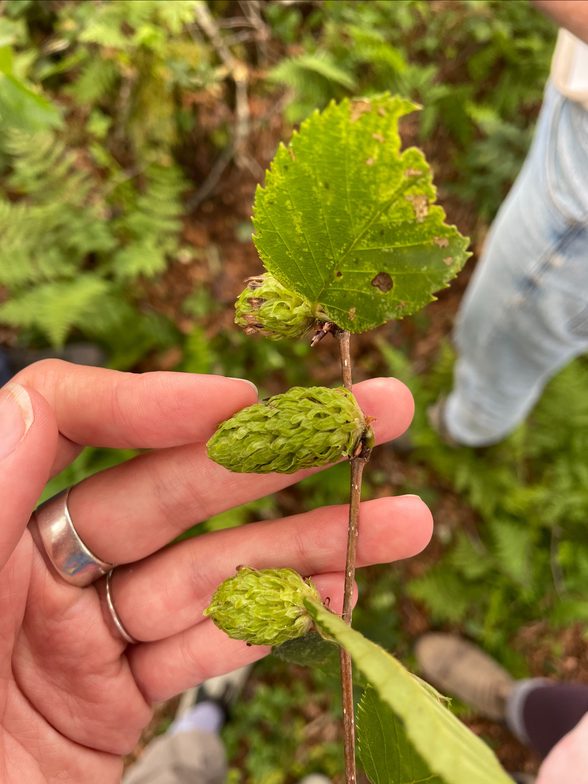Discover the Wabanaki-Acadian Forest with Thriving Forests
Spotlight on Yellow birch – Betula alleghaniensis – mnnoqon

Through Thriving Forests program, we will delve into the Wabanaki-Acadian Forest by spotlighting various tree species each month to understand the biodiversity and ecological importance of our unique forest ecosystem in Nova Scotia. This month, our focus is on the yellow birch, the largest and longest-lived birch species.
Native birch species in our province include white (paper) birch, gray birch, mountain paper birch and yellow birch. Although yellow birch can grow well on a wide variety of sites, it’s commonly found on rich soils alongside species such as beech, sugar maple and hemlock. Yellow birch, white birch and mountain paper birch can all grow to be large trees, while gray birch tends to be small.
How yellow birch wood is used
Yellow birch wood is typically light in colour and is commonly used for flooring, furniture, cabinetry and veneer. However, the bark is not often used the same way as white birch bark because it doesn’t peel easily.
Birch sap can be used to make syrup, but it takes 80+ liters of birch sap to produce just one liter of syrup, whereas it only takes 40 liters of maple sap to make the same amount. Mi’kmaq people have used yellow birch for many things, including making twine, thongs, snowshoes, medicine and even hockey sticks.

Yellow birch is darker in colour and peels in thin shreds.

White birch bark is usually white and can peel in large sheets.
Identifying yellow birch species
Distinguishing between different birch species can be challenging when examining only one feature. Therefore, it is helpful to consider several features together.
- Yellow birch twigs smell like wintergreen when scraped.
- Yellow and white birch have hair on new twigs, while gray and mountain paper birch have hairless twigs.
- Yellow birch is commonly found on moist, rich sites and it’s the most shade tolerant birch.
- White birch and gray birch are not shade tolerant and are often some of the first trees to grow in a disturbed area.
- Mountain paper birch tends to grow on upper elevations or in cooler areas.

Yellow birch: Triangular, usually has a rounded base

White birch: Triangular, usually has a rounded base

Gray birch:
Tapers to a fine point

Mountain paper birch: Heart-shaped where leaf joins stalk
Identifying mature yellow birch seeds
Yellow birch seeds begin to ripen during late-September throughout October in Atlantic Canada and they produce fruits known as catkins or strobiles that grow to 3-4 cm in length.


When mature, a catkin’s cone-like shape changes to a golden-brown, which is composed of many tiny scales. Each of these tiny scales is a samara containing three narrow lobes (imagine the shape of a bird’s foot), carrying two winged nutlets that are only 3-4 mm in length.
Hundreds of seeds may be contained within an individual catkin. These mature catkins can be observed standing upright along the branches. Although seed catkins mature around late-September, they may remain on the tree throughout the winter.
Collecting seeds from yellow birch
We recommend hand-picking from the branch for collecting birch seeds. Yellow birch catkins are known as dehiscent fruits, which means they release their seeds. Since winged seeds are highly airborne with the presence of wind, the easiest collection method is to use pole hooks to pull branches towards the ground for easier access.

Image: Natural Resources Canada – Yellow birch
Tips on collecting seeds
- Permission: Make sure you have permission to gather seeds from the area you’re visiting.
- Documentation: Create an identification tag about the species, tree location, GPS coordinates and date.
- Cut test: Before collecting, conduct a cut test on 20 seeds per tree using a pipe cutter or a safe blade while wearing gloves to verify that the seeds are healthy and viable.

Storing yellow birch seeds
Dehiscent fruits should be stored in a cool, dry, well-ventilated area and must be surface-dried while protected from the elements. Ensure daily stirring to maintain even drying and prevent damage from heating and mold. For long–term storage and to maintain good viability, individual seeds must be de-winged and can be kept in a sealed container.
To join our network of tree monitors or if you know a stand of trees in your community that you would like to direct us to, please reach out via thrivingforests@cleanfoundation.ca.
If you are interested in learning more about Thriving Forests program, click below.
Recent Comments